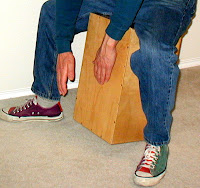Lots of possibilities with the cabasa!
Experiment with these patterns:
Percussion For Worship (TM) provides information for percussionists, worship leaders, producers, teachers, and anyone desiring to learn about the use of this family of instruments in both contemporary and traditional Christian worship.

 When Robert (a Peruvian) asked that question, I knew that he was referring to the cajon. Simple, portable, and possessing a variety of timbres, the cajon is a great choice for the "no drumset" situation. With bass tones produced in the center of the main playing surface (front panel) and crisp highs at the upper corners, you can coax a pretty meaty groove out of the box.
When Robert (a Peruvian) asked that question, I knew that he was referring to the cajon. Simple, portable, and possessing a variety of timbres, the cajon is a great choice for the "no drumset" situation. With bass tones produced in the center of the main playing surface (front panel) and crisp highs at the upper corners, you can coax a pretty meaty groove out of the box. A foot operated looper allows you to record, stop, play, and erase without using your hands. No fumbling for a button while holding a stick or mallet!
A foot operated looper allows you to record, stop, play, and erase without using your hands. No fumbling for a button while holding a stick or mallet! Given to me by a mentor years ago, my copy of Expression in Music carries a price marking of $2. The cost has more than doubled yet this inexpensive tome contains a wealth of information on musical phrasing. Famed cornetist, composer, and educator, H.A. Vandercook gives specific directions on emphasis, interpretation, ornamental notes, syncopation, and more. Though published in the 1920’s, the ideas in the book are timeless and can be applied whether playing the lead line or accompaniment.
Given to me by a mentor years ago, my copy of Expression in Music carries a price marking of $2. The cost has more than doubled yet this inexpensive tome contains a wealth of information on musical phrasing. Famed cornetist, composer, and educator, H.A. Vandercook gives specific directions on emphasis, interpretation, ornamental notes, syncopation, and more. Though published in the 1920’s, the ideas in the book are timeless and can be applied whether playing the lead line or accompaniment.